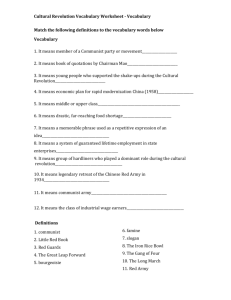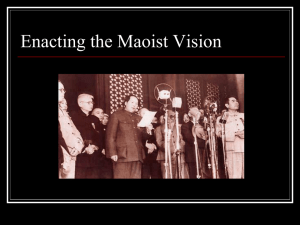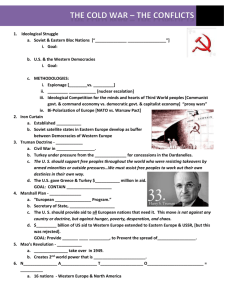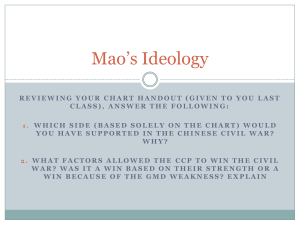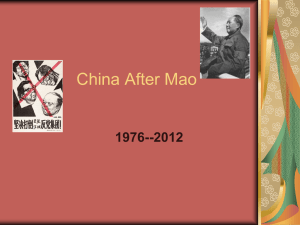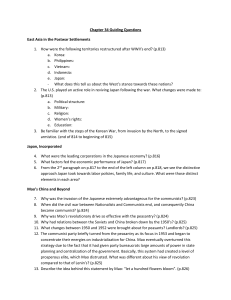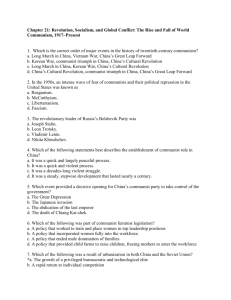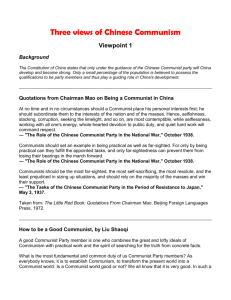Shifting Winds of Communist China
advertisement
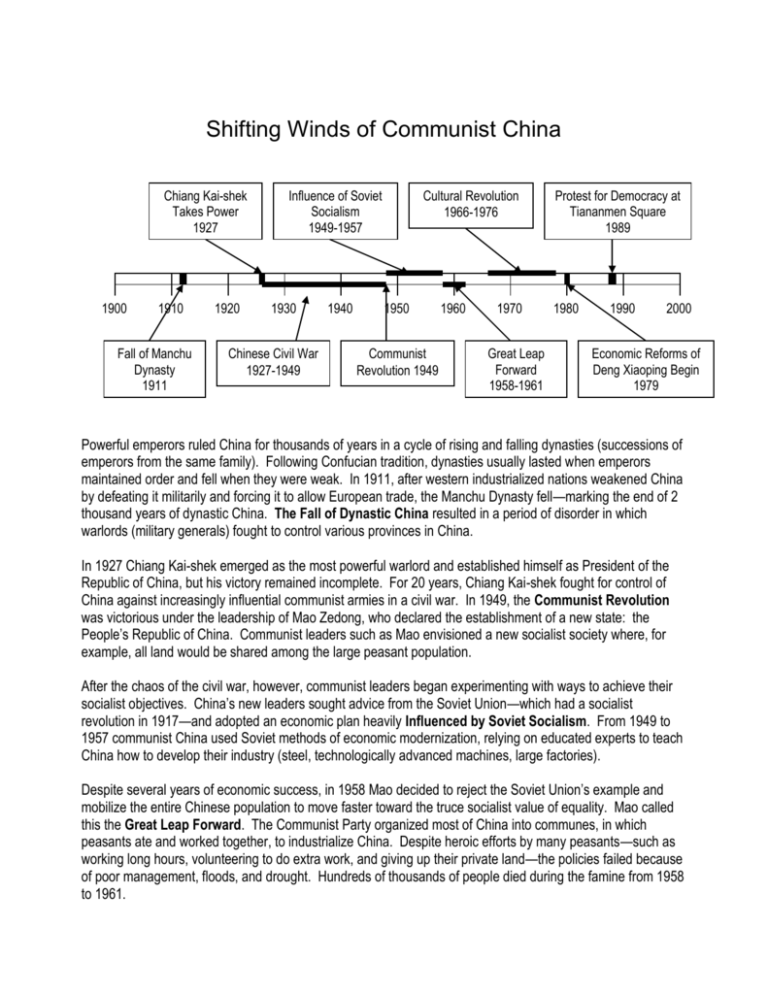
Shifting Winds of Communist China Chiang Kai-shek Takes Power 1927 1900 1910 Fall of Manchu Dynasty 1911 1920 Influence of Soviet Socialism 1949-1957 1930 Chinese Civil War 1927-1949 1940 Cultural Revolution 1966-1976 1950 Communist Revolution 1949 1960 1970 Great Leap Forward 1958-1961 Protest for Democracy at Tiananmen Square 1989 1980 1990 2000 Economic Reforms of Deng Xiaoping Begin 1979 Powerful emperors ruled China for thousands of years in a cycle of rising and falling dynasties (successions of emperors from the same family). Following Confucian tradition, dynasties usually lasted when emperors maintained order and fell when they were weak. In 1911, after western industrialized nations weakened China by defeating it militarily and forcing it to allow European trade, the Manchu Dynasty fell—marking the end of 2 thousand years of dynastic China. The Fall of Dynastic China resulted in a period of disorder in which warlords (military generals) fought to control various provinces in China. In 1927 Chiang Kai-shek emerged as the most powerful warlord and established himself as President of the Republic of China, but his victory remained incomplete. For 20 years, Chiang Kai-shek fought for control of China against increasingly influential communist armies in a civil war. In 1949, the Communist Revolution was victorious under the leadership of Mao Zedong, who declared the establishment of a new state: the People’s Republic of China. Communist leaders such as Mao envisioned a new socialist society where, for example, all land would be shared among the large peasant population. After the chaos of the civil war, however, communist leaders began experimenting with ways to achieve their socialist objectives. China’s new leaders sought advice from the Soviet Union—which had a socialist revolution in 1917—and adopted an economic plan heavily Influenced by Soviet Socialism. From 1949 to 1957 communist China used Soviet methods of economic modernization, relying on educated experts to teach China how to develop their industry (steel, technologically advanced machines, large factories). Despite several years of economic success, in 1958 Mao decided to reject the Soviet Union’s example and mobilize the entire Chinese population to move faster toward the truce socialist value of equality. Mao called this the Great Leap Forward. The Communist Party organized most of China into communes, in which peasants ate and worked together, to industrialize China. Despite heroic efforts by many peasants—such as working long hours, volunteering to do extra work, and giving up their private land—the policies failed because of poor management, floods, and drought. Hundreds of thousands of people died during the famine from 1958 to 1961. After the failure of the Great Leap Forward, Mao softened his desire to immediately achieve the socialist goals of the revolution. After several years, Mao feared that the economic success during this period had caused economic inequality—upper and lower classes—similar to what had existed before the Communist Revolution. In 1066 Mao concluded that modern China needed a Cultural Revolution to rid itself of what he referred to as the “four olds”—old ideas, old culture, old customs, and old habits—that were rooted in pre-Revolutionary culture. To do this, Mao called on young people, later referred to as Red Guards, to guard the culture of the revolution. They did this often by humiliating and imprisoning “enemies” of the people, primarily educated Chinese, city dwellers, and corrupt Communist Party officials. The Cultural Revolution ended when Mao died in 1976. After three years of power struggle among leaders of the Communist Party, Deng Xiaoping became the most powerful leader of China in 1979. In contrast to the extreme socialist values of the Cultural Revolution, the Economic Reforms of Deng Xiaoping shifted the focus of the government back to making China strong economically. For example, the communists now permitted peasants to grow crops on their own private plots for sale for profit at local markets. Deng called his reforms the Four Modernizations—science, industry, technology, and defense—and argued that there were needed to modernize China. After 10 years of successful economic reforms under Deng Xiaoping, many people began to call for political reforms as well. In 1989 students held a Protest for Democracy at Tiananmen Square, the main public square in the capital city of Beijing, demanding that the communist leaders allow political freedoms, such as democracy. At first the government did nothing to stop the nonviolent protests n the heart of the Chinese capital, even as some students went on hunger strikes as acts of protest. Finally, after weeks of international attention, Deng called in the army to use force to clear the square, which it did, killing dozens of students. Protesters were arrested and sentenced to prison. The international community was outraged at the result of the Tiananmen Square protest, but Dent remained in power and no political reforms occurred.
